
Nutritional food pairs
You probably already know that peanut butter and jelly, not to mention maple and walnuts, are naturals together. But science is continually discovering less obvious food pairs that can offer a wide range of health benefits, from lowering cholesterol to improving eyesight. When we eat certain foods together, their nutrients or antioxidants work in sync-producing a synergistic health benefit that’s not realized when these foods are eaten alone. To up the nutrition in meals, try the following food pairings.

Pair pasta with red wine vinegar
Why? Together they keep you feeling full
Red wine vinegar (like other types of vinegar) contains acetic acid, which research has shown reduces the spike in blood sugar that occurs after consuming starchy foods high in carbohydrates such as pasta, rice and bread. A steadier rise in blood sugar reduces hunger by keeping you feeling satiated, as well as helping to minimize the risk of developing type 2 diabetes. (And by the way: Cinnamon also has blood-glucose-lowering abilities, so sprinkle it on oatmeal or add to the water used to cook rice.)
Try this:
Pasta salad with red wine vinegar dressing
In a small bowl, whisk together 3 tablespoons (45 mL) extra virgin olive oil, 2 tablespoons (30 mL) red wine vinegar, 1 teaspoon (5 mL) grainy mustard, and salt and pepper to taste. Set aside. Cook a 454-gram package of whole-grain rotini according to package directions and toss with 2 small cans drained salmon, 2 handfuls of spinach, 1 sliced roasted red pepper, 1 pint halved cherry tomatoes and the red wine vinegar dressing. Makes 4 side-dish servings (or divide in 2 and make it a meal.)

Pair tempeh with leeks
Why? Together they help your heart
In 2010, researchers at St. Michael’s Hospital in Toronto showed that the joint consumption of inulin (a prebiotic substance found in leeks, onions, garlic, Jerusalem artichokes and chicory) with soy protein and soy isoflavones can reduce LDL ( “bad”) cholesterol while simultaneously raising HDL ( “good”) cholesterol. This improved ratio can reduce the risk of clogged arteries and heart disease. Tofu, tempeh and edamame are all excellent sources of soy protein and isoflavones.
Try:
Vegetarian tempeh and leek chili
In a large saucepan, heat 1 tablespoon (15 mL) oil over medium heat. Add 2 sliced leeks and 2 chopped garlic cloves; cook 3 minutes. Stir in a 227-g package of diced tempeh, 2 sliced carrots, 2 sliced celery stalks and 1 diced red bell pepper; cook 5 minutes. Stir in a 796-mL can of diced tomatoes, a 177-mL can of tomato paste, a 562-mL can of kidney beans (drained and rinsed), 1 teaspoon (5 mL) cumin, 1 teaspoon dried oregano, 1/2 teaspoon (2 mL) chili powder and 1/4 teaspoon (1 mL) each salt and pepper; simmer for 15 minutes. Makes 4 servings.

Pair chicken with grapefruit
Why? Together they boost energy
Poultry, beef, pork and fish are all top dietary sources of coenzyme Q10 (CoQ10). This “power plant” of our body’s cells plays a vital role in the production of the energy we use for everything from digesting food to running on a treadmill. The coenzyme may also help control blood pressure in those with hypertension. A 2010 Japanese study discovered that eating grapefruit allows up to 50 percent higher cellular absorption of CoQ10 (grapefruit appears to inhibit a protein in the membrane of cells that limits CoQ10 uptake).
Try this:
Chicken breast with zesty grapefruit salsa
Peel 2 grapefruit and cut the segments into chunks. Toss in a medium bowl with 1/2 diced red onion, 1 diced red bell pepper, 1 diced jalapeño pepper, a handful of torn basil leaves, a handful of dried cranberries or cherries, 2 splashes of orange juice and salt to taste. Set aside. In a sauté pan, heat a little canola oil over medium heat. Cook 2 boneless, skinless chicken breasts until they’re no longer pink inside, about 6 minutes per side. Slice chicken and serve it topped with the grapefruit salsa. Makes 2 meal-size servings.
Related:
• 10 food pairs to supercharge your diet
• 4 healthy superfood pairs
• 10 foods you should eat every day
